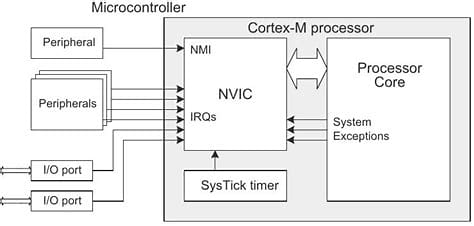The Nested Vectored Interrupt Controller (NVIC) is a crucial component in ARM Cortex-M microcontroller architectures, designed to manage and prioritize interrupts efficiently. It allows for the handling of multiple interrupt sources, enabling responsive and real-time applications. Below is a detailed overview of the NVIC, including its features, functionality, and applications.

Overview of NVIC
The NVIC is integrated into ARM Cortex-M microcontrollers and is responsible for managing interrupt requests (IRQs) from various peripherals and system events. It supports nested interrupts, meaning that higher-priority interrupts can preempt lower-priority ones, allowing for more responsive systems.
Key Features
Nested Interrupts:
- The NVIC supports nested interrupts, allowing higher-priority interrupts to interrupt lower-priority ones. This feature is essential for real-time applications where timely responses to critical events are required.
Prioritization:
- Each interrupt can be assigned a priority level, enabling the system to determine which interrupt should be serviced first. The NVIC can handle up to 256 priority levels, depending on the specific Cortex-M implementation.
Vector Table:
- The NVIC uses a vector table to map interrupt sources to their corresponding service routines (ISR). Each interrupt has a unique vector address that points to its handler function.
Dynamic Priority Changes:
- The NVIC allows for dynamic changes to interrupt priorities during runtime, enabling flexible control over interrupt handling based on application needs.
Interrupt Masking:
- The NVIC can mask (disable) specific interrupts, preventing them from being serviced while critical sections of code are executing. This feature helps maintain data integrity and system stability.
Efficient Context Switching:
- The NVIC is designed to minimize the overhead associated with context switching between different interrupt service routines, enhancing overall system performance.
Fault Handling:
- The NVIC can also handle system faults, such as hard faults, memory management faults, and usage faults, providing a mechanism for error handling and recovery.
Functionality
- Interrupt Request Handling: The NVIC receives interrupt requests from various peripherals and determines the appropriate response based on priority levels.
- Interrupt Vectoring: When an interrupt occurs, the NVIC uses the vector table to jump to the corresponding ISR, executing the necessary code to handle the interrupt.
- Priority Management: The NVIC manages the priorities of active interrupts, ensuring that higher-priority interrupts are serviced before lower-priority ones.
- Enabling/Disabling Interrupts: The NVIC allows software to enable or disable specific interrupts, providing control over which events can trigger an ISR.
Applications
- Embedded Systems: The NVIC is widely used in embedded systems for managing interrupts from sensors, communication interfaces, and other peripherals.
- Real-Time Operating Systems (RTOS): In RTOS environments, the NVIC plays a critical role in managing task scheduling and interrupt handling, ensuring timely responses to events.
- Consumer Electronics: Devices such as smart appliances, wearables, and IoT devices utilize the NVIC for efficient interrupt management.
- Automotive Applications: The NVIC is used in automotive control systems for managing various sensors and actuators, ensuring responsive and reliable operation.
Conclusion
The Nested Vectored Interrupt Controller (NVIC) is a vital component in ARM Cortex-M microcontrollers, providing efficient and flexible interrupt management. Its support for nested interrupts, prioritization, and dynamic control makes it essential for real-time applications and embedded systems. By enabling responsive handling of multiple interrupt sources, the NVIC enhances the performance and reliability of various electronic devices and systems.